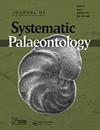A new proterochampsid (Archosauriformes: Proterochampsia) from the Late Triassic of southern Brazil and the emergence of archosaurian hind limb traits
IF 2.2
2区 地球科学
Q3 EVOLUTIONARY BIOLOGY
引用次数: 2
Abstract
Characterized by an elongated snout, proterochampsids are carnivorous non-archosaur archosauriforms. The clade is endemic to South America and its fossil record extends from the early Carnian to the late Carnian/early Norian. Nesting close to Archosauria, it is a key clade for understanding the origin and evolution of archosaurian traits. Unfortunately, hind limb elements are usually poorly preserved for the group. Therefore, the hind limb anatomy of proterochampsids still lacks detailed descriptions. In the present study, we partially fill this gap with the description of a new proterochampsid represented by a complete and well-preserved hind limb. Stenoscelida aurantiacus gen. et sp. nov. was excavated from the late Carnian/early Norian (Late Triassic) beds of southern Brazil. A phylogenetic investigation recovers the new taxon as a non-rhadinosuchine proterochampsid. The species bears an unusual set of traits for the group, which provides clues on the evolutionary origins of some muscle attachment structures. For instance, the femur of Stenoscelida aurantiacus gen. et sp. nov. possesses an anterior trochanter and an anterolateral scar. So far, these features have not been reported in other non-archosaurian archosauriforms. Therefore, the new specimen indicates that some typical archosaurian features evolved earlier than previously thought. The taxon also carries additional uncommon features for proterochampsids, such as an iliofibularis tubercle on the anterior margin of the fibula and a vestigial phalanx in digit V. In sum, Stenoscelida aurantiacus has one of the best-preserved hind limbs within Proterochampsidae and sheds light on the polarization of important traits regarding the evolutionary context of Archosauria. http://zoobank.org/urn:lsid:zoobank.org:pub:C78B7CE3-AB9B-4543-833E-B2A3FEA957D9巴西南部晚三叠世一种新的原龙类(原龙目:原龙目)及其后肢特征的出现
以细长的吻为特征的变形龙是肉食性的非长龙类长龙形目。该分支是南美洲的特有分支,其化石记录从卡尼阶早期延伸到卡尼阶晚期/诺里阶早期。它与始龙类接近,是了解始龙类特征起源和进化的关键分支。不幸的是,后肢元素通常保存得很差。因此,变形汉蛛的后肢解剖仍然缺乏详细的描述。在本研究中,我们通过描述一种新的变形虫来部分填补这一空白,该变形虫以完整且保存完好的后肢为代表。aurantiacus gen.et sp.nov.是从巴西南部卡尼阶晚期/诺里阶早期(三叠纪晚期)地层中挖掘出来的。一项系统发育调查将新的分类单元恢复为非rhadinosuchine proterochampsid。该物种具有一组不同寻常的特征,这为一些肌肉附着结构的进化起源提供了线索。例如,aurantiacus gen.et sp.nov.的股骨具有前转子和前外侧瘢痕。到目前为止,这些特征还没有在其他非长龙类长龙形目中被报道。因此,这个新标本表明,一些典型的上龙类特征比之前认为的进化得更早。该分类单元还具有变形龙类的其他不常见特征,如腓骨前缘的髂腓骨结节和手指V中的残余指骨。总之,Aurantiaus Stenoscelida拥有变形龙科中保存最完好的后肢之一,并揭示了与长龙类进化背景有关的重要特征的两极分化。http://zoobank.org/urn:lsid:zoobank.org:pub:C78B7CE3-AB9B-4533-833E-2a3ea957d9
本文章由计算机程序翻译,如有差异,请以英文原文为准。
求助全文
约1分钟内获得全文
求助全文
来源期刊
CiteScore
5.30
自引率
7.70%
发文量
31
审稿时长
>12 weeks
期刊介绍:
The Journal of Systematic Palaeontology publishes papers that provide novel and impactful results in phylogenetics and systematics and that use these results in ways that significantly advance rigorous analyses of palaeogeography, palaeobiology, functional morphology, palaeoecology or biostratigraphy. Papers dealing with theoretical issues or molecular phylogenetics are also considered if they are of relevance to palaeo-systematists. Contributions that include substantial anatomical descriptions, descriptions of new taxa or taxonomic revisions are welcome, but must also include a substantial systematics component, such as a new phylogeny or a revised higher-level classification. Papers dealing primarily with alpha-taxonomic descriptions, the presentation of new faunal/floristic records or minor revisions to species- or genus-level classifications do not fall within the remit of the journal.

 求助内容:
求助内容: 应助结果提醒方式:
应助结果提醒方式:


